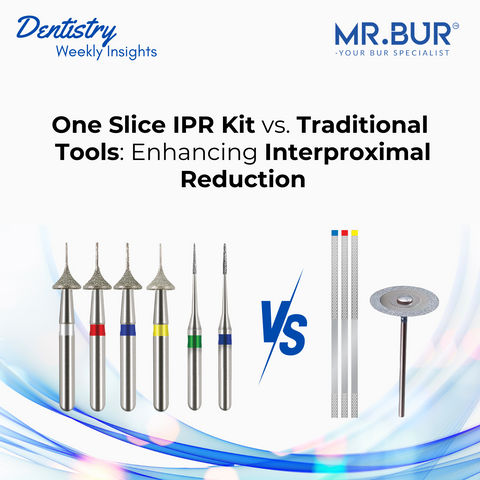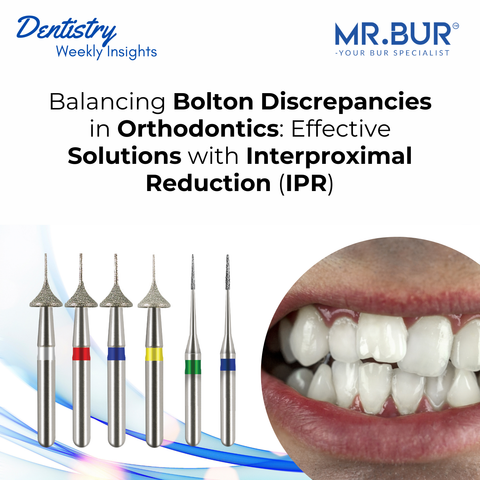Interproximal Reduction (IPR) is an effective orthodontic technique widely used to create space between teeth, facilitating better alignment. While it offers significant advantages, including improved esthetics and space management, it’s essential for dental professionals to be aware of potential risks and complications that may arise if IPR is not performed correctly or if patients do not maintain optimal oral hygiene afterward. This article will explore the four main dental complications associated with IPR, how to prevent them, and best practices for safe IPR.
Understanding IPR: An Overview
IPR involves the precise removal of a thin layer of enamel from the proximal surfaces of teeth, creating space for teeth to move into better alignment. It’s commonly used in conjunction with aligners, braces, and other orthodontic appliances to improve crowding and alignment.
Key Benefits of IPR
- Allows for improved tooth alignment in crowded areas
- Reduces the need for extractions in mild to moderate crowding cases
- Helps adjust tooth size discrepancies
- Improves the overall esthetics of the smile
While the benefits are clear, it’s important to be aware of the potential complications that may arise from IPR. The following sections detail the major dental issues that can develop as a result of IPR and how to prevent them.
1. Tooth Sensitivity After IPR
Tooth sensitivity is one of the most common complications following IPR. Since IPR involves enamel removal, it can expose the underlying dentin, which contains tubules that connect to the tooth's nerve, resulting in increased sensitivity.
Why It Happens
- Enamel Removal: Enamel acts as a protective barrier for the tooth. Removing enamel can expose the dentin layer, making the tooth more sensitive to external stimuli like hot, cold, or sweet substances.
- Depth of Reduction: Deeper reductions, particularly those exceeding 0.5mm, increase the risk of dentin exposure.
Prevention Strategies
- Conservative Reduction: Use calibrated IPR burs, such as Mr. Bur One Slice IPR Kit, to maintain precise enamel reduction between 0.3mm to 0.5mm per slice, reducing the risk of dentin exposure.
- Fluoride Varnish Application: Post-IPR fluoride varnish can help strengthen the remaining enamel and reduce sensitivity by occluding the exposed dentin tubules.
2. Increased Risk of Tooth Decay
IPR can increase the risk of interproximal caries if plaque or food debris accumulates in the newly created spaces. Proper oral hygiene becomes even more critical after IPR to maintain optimal dental health.
Why It Happens
- Newly Created Spaces: The reduction creates gaps that can harbor plaque if not cleaned effectively.
- Weakened Enamel: Reduced enamel can be more susceptible to acid attacks, increasing the likelihood of decay.
Prevention Strategies
- Oral Hygiene Instructions: Provide patients with clear instructions on maintaining oral hygiene, including using interdental brushes, flossing techniques, and fluoride mouth rinses.
- Fluoride Treatments: Recommend fluoride toothpaste or gels to reinforce enamel strength and prevent decay.
- Regular Monitoring: Conduct periodic radiographs to monitor for early signs of decay in the interproximal areas.
3. Periodontal Disease
Inadequate cleaning of the interproximal areas post-IPR can lead to plaque buildup, potentially resulting in periodontal disease if left untreated.
Why It Happens
- Plaque Accumulation: The spaces created by IPR can be difficult for patients to clean effectively, leading to plaque accumulation and inflammation.
- Gingival Health Compromise: If plaque remains in the interproximal areas, it can contribute to pocket formation and eventual bone loss.
Prevention Strategies
- Patient Education: Instruct patients on proper interdental cleaning techniques and the importance of professional cleanings.
- Use of Antibacterial Rinses: Advise patients to use chlorhexidine or similar antibacterial rinses to minimize bacterial load in interproximal areas.
4. Root Resorption
Root resorption is a rare but potential complication associated with aggressive IPR, particularly when combined with orthodontic forces.
Why It Happens
- Excessive Enamel Removal: Aggressive IPR increases the mechanical forces on the tooth, potentially leading to resorption of the tooth’s root.
- Increased Orthodontic Forces: Applying significant orthodontic pressure to teeth after IPR can exacerbate the risk of root resorption.
Prevention Strategies
- Conservative IPR Techniques: Use precise IPR burs like those in Mr. Bur One Slice IPR Kit, which ensures accurate enamel reduction and controlled space creation.
- Incremental Adjustments: Implement a gradual approach to IPR and tooth movement to minimize mechanical stress on the roots.
- Radiographic Monitoring: Use periodic radiographs to monitor any signs of root resorption, allowing for early intervention if needed.
Poor IPR technique can lead to serious complications, including excessive enamel removal, which weakens tooth structure and causes sensitivity; root resorption, resulting in tooth mobility or loss; increased risk of periodontal disease due to plaque traps; irreversible tooth sensitivity from dentin exposure; and improper tooth movement, which can prolong treatment or cause malalignment. Ensuring precision and control during IPR is essential to prevent these issues and achieve successful orthodontic outcomes.
Common Misconceptions About IPR
"IPR Damages Teeth Irreversibly"
A common misconception about Interproximal Reduction (IPR) is that it causes irreversible damage by removing large amounts of enamel. In practice, IPR is a highly controlled procedure, removing only a very thin layer of enamel—typically between 0.1mm and 0.5mm. Tools like Mr. Bur's One Slice IPR Kit, calibrated between 0.3mm and 0.5mm, provide precise enamel reduction for creating the necessary space for tooth alignment, while preserving tooth integrity. Additionally, Mr. Bur's IPR strips offer even finer adjustments, with options 0.08mm to 0.16mm, allowing for a highly tailored approach to space creation without compromising enamel health.
"IPR Is Painful"
Another common myth is that IPR is a painful process. When performed correctly, IPR is generally a comfortable procedure with minimal discomfort. Dentists often use local anesthesia or topical desensitizing agents when necessary to ensure patient comfort during the process. Furthermore, the use of precise, sharp IPR burs reduces friction and heat, making the procedure minimally invasive. Patients may experience slight sensitivity after IPR, but this is temporary and can be managed with desensitizing toothpaste or fluoride treatments. Overall, with the right technique and tools, IPR should not be a painful experience for patients.
Discover More:
1. Types of Braces in Orthodontics and Tooth Preparation: Using IPR Burs for Optimal Outcomes
2. Understanding and Reducing Black Triangles in Dentistry: When to Use IPR
4. Step-by-step guide to Interproximal Bur Technique: The bur used for IPR
MR. BUR UNITED KINGDOM we provide a wide range of dental burs selection in global.
Diamond Burs, Carbide Burs, Surgical & Lab Use Burs, Endodontic burs, IPR Kit, Crown Cutting Kit, Gingivectomy Kit, Root Planning Kit, Composite Polishers, High Speed Burs, Low Speed Burs
Subscribe our newsletter now!


